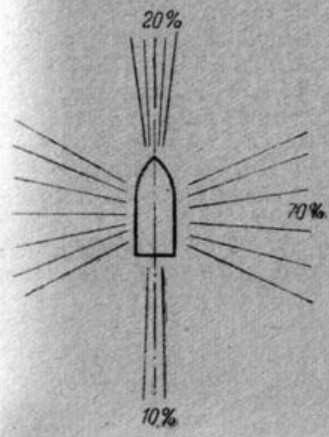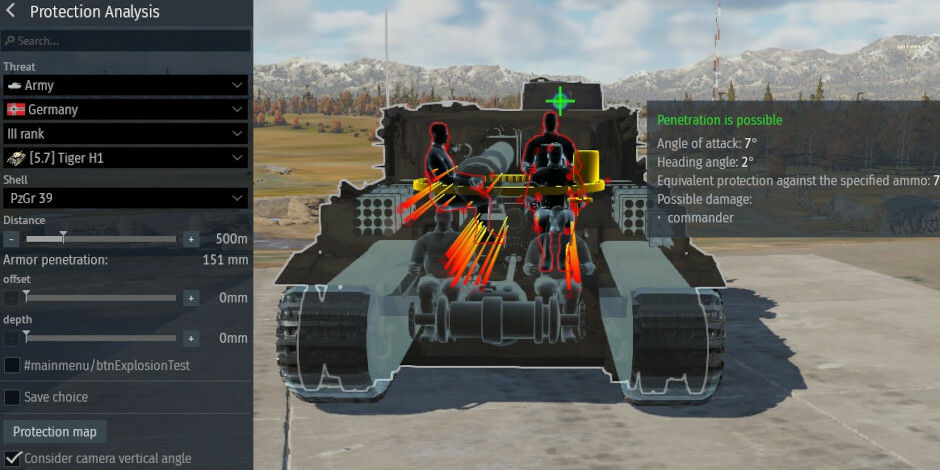
Today, we’ll be talking about changes to the post-pen effects for APHE shells used by ground vehicles that we plan to introduce into the game. We’re ready to show you what we have planned here, and at the end of this news post you can participate in voting for or against — whether there’ll be changes or not all depends on your vote. Let’s take a look!
Preserving fragments in the head part of the shell First off, we’d like to tell you about a change that we consider necessary and will be implemented into the game without any vote. This change relates to maintaining the integrity of an APHE shell’s head after armor penetration. When an APHE shell explodes, its warhead is not subject to significant fragmentation and can cause substantially greater damage than the scattering fragments of the case and base.
 Fragments of a 75mm M61 shell after it exploded. Note how intact the warhead is
Fragments of a 75mm M61 shell after it exploded. Note how intact the warhead is The fragment of the shell’s warhead is significant in mass, can penetrate armor of considerable thickness, and at the same time also form secondary fragments when penetrating armor. This change will allow the warhead to better hit enemy crew members located behind internal partitions, such as the engine compartment bulkhead, as well as other modules along the shell’s flight trajectory that cannot be penetrated by small fragments generated from the shell exploding.
Increasing secondary fragments and high explosive damage Due to a number of technical reasons, secondary fragments from APHE shells differ and are worse compared to fragments from regular, solid AP shells. When reworking fragmentation fields, we’ll enhance the secondary fragments of APHE shells to the level of solid AP shells.
The high-explosive damage from APHE shells will remain — it causes relatively little damage, affects the crew and modules inside the tank and has a damage zone in the form of a sphere around the detonation point of the shell. The diameter of the damage sphere of high-explosive damage is noticeably smaller than the scattering zone of secondary fragments.
Implementing fragment areas Here are the changes that we’d like you to vote on, whether they’re introduced or not will be determined by community vote: scattering sectors of fragments from APHE shells.
When a shell explodes, three main fragmentation areas are formed, shown in the image below:
- The remainder of the shell’s head and its fragments.
- Fragments from the base of the shell.
- Fragments from all sides of the shell (the case).

When a shell explodes inside of a tank or armored vehicle, the shell’s head acts as a small solid AP round and may penetrate more internal modules. Alongside this, smaller fragments from the shell casing form a fragmentation cone and hit the crew and modules around the explosion point. We plan to implement both of these to the game.
 *Translation (Pic.113): Scattering of the APHE shell fragments on impact
*Translation (Pic.113): Scattering of the APHE shell fragments on impactAt the moment, we use a simplified fragmentation pattern for APHE shells in the game without segmentation into different areas. If we were to implement the proposed physically reliable sector fragmentation patterns for APHE shells, the post-pen effect of APHE shells will be more realistic. However, when hitting protruding modules, such as the commander’s cupola, the probability of crew damage would be reduced.
 Damage probability from the explosion of a BR-412D shell behind armor with the current fragment distribution
Damage probability from the explosion of a BR-412D shell behind armor with the current fragment distribution Damage probability in the same scenario with the proposed fragment spread
Damage probability in the same scenario with the proposed fragment spreadReworking the post-pen effects of APHE shells can change the tactics of the game, making protruding weakened areas less vulnerable. However at the same time, post-pen effects after penetrating the hull of a vehicle due to the preservation of the shell’s head after the shell explodes will be increased.
In-game examples of the described changes Here’s some screenshots of how damage to ground vehicles will be altered with the changes implemented.
Before — post-pen effect when penetrating the center of a tank without preserving the head of the shell:
 After
After — post-pen effect when penetrating the center of a tank while preserving the head of the shell:
 Before
Before — post-pen effect when the commander’s cupola is hit by a spherical spread of fragments from a shell explosion:
 After
After — post-pen effect when the commander’s cupola is hit with a physically reliable sectoral scattering of fragments from the shell explosion:

We’d like to hear your opinion on this — share it in the comment field and vote Yes or No for the changes to post-pen effects in the poll!
We’re planning to give players the opportunity to test these changes in a special game event, as well as the “Protection Analysis” menu, before applying these changes to all APHE shells in the game. However, preparing this testing will require some significant time from the development team, so today we want to collect your opinions on whether you’re interested in switching to a more detailed damage model for APHE shells. So, shall we test it?
ADD YOUR VOTE HERE[poll.gaijin.net]If you’re interested in testing, we’ll start preparing it and will host another voting on this change based on its results.









